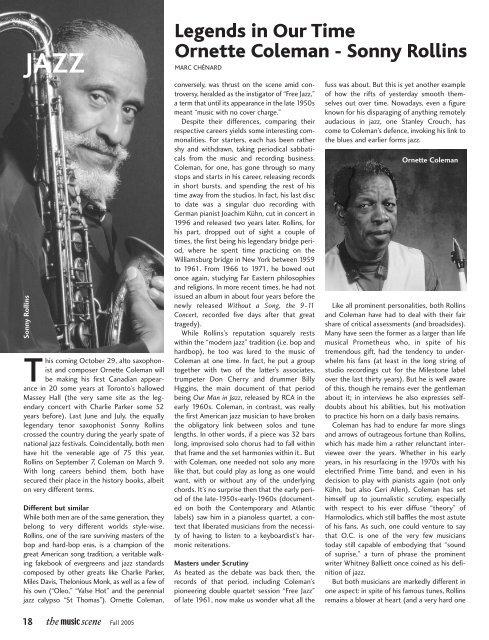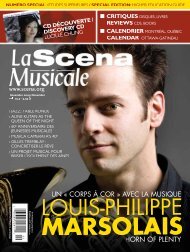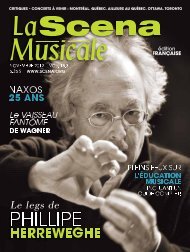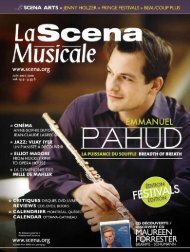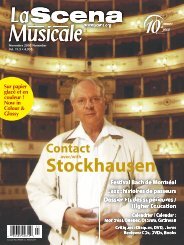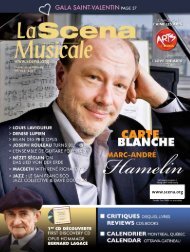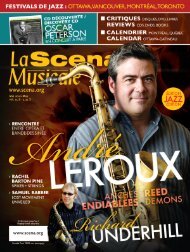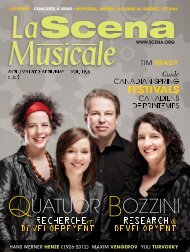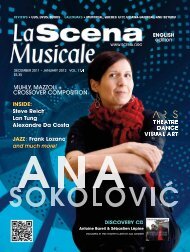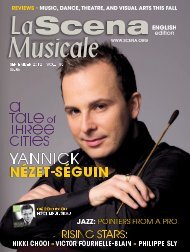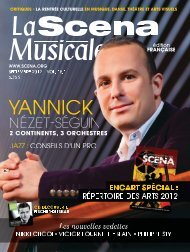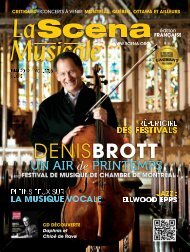Download - La Scena Musicale
Download - La Scena Musicale
Download - La Scena Musicale
You also want an ePaper? Increase the reach of your titles
YUMPU automatically turns print PDFs into web optimized ePapers that Google loves.
JAZZ<br />
Sonny Rollins<br />
This coming October 29, alto saxophonist<br />
and composer Ornette Coleman will<br />
be making his first Canadian appearance<br />
in 20 some years at Toronto’s hallowed<br />
Massey Hall (the very same site as the legendary<br />
concert with Charlie Parker some 52<br />
years before). <strong>La</strong>st June and July, the equally<br />
legendary tenor saxophonist Sonny Rollins<br />
crossed the country during the yearly spate of<br />
national jazz festivals. Coincidentally, both men<br />
have hit the venerable age of 75 this year,<br />
Rollins on September 7, Coleman on March 9.<br />
With long careers behind them, both have<br />
secured their place in the history books, albeit<br />
on very different terms.<br />
Different but similar<br />
While both men are of the same generation, they<br />
belong to very different worlds style-wise.<br />
Rollins, one of the rare surviving masters of the<br />
bop and hard-bop eras, is a champion of the<br />
great American song tradition, a veritable walking<br />
fakebook of evergreens and jazz standards<br />
composed by other greats like Charlie Parker,<br />
Miles Davis, Thelonious Monk, as well as a few of<br />
his own (“Oleo,” “Valse Hot” and the perennial<br />
jazz calypso “St Thomas”). Ornette Coleman,<br />
Legends in Our Time<br />
Ornette Coleman - Sonny Rollins<br />
MARC CHÉNARD<br />
conversely, was thrust on the scene amid controversy,<br />
heralded as the instigator of “Free Jazz,”<br />
a term that until its appearance in the late 1950s<br />
meant “music with no cover charge.”<br />
Despite their differences, comparing their<br />
respective careers yields some interesting commonalities.<br />
For starters, each has been rather<br />
shy and withdrawn, taking periodical sabbaticals<br />
from the music and recording business.<br />
Coleman, for one, has gone through so many<br />
stops and starts in his career, releasing records<br />
in short bursts, and spending the rest of his<br />
time away from the studios. In fact, his last disc<br />
to date was a singular duo recording with<br />
German pianist Joachim Kühn, cut in concert in<br />
1996 and released two years later. Rollins, for<br />
his part, dropped out of sight a couple of<br />
times, the first being his legendary bridge period,<br />
where he spent time practicing on the<br />
Williamsburg bridge in New York between 1959<br />
to 1961. From 1966 to 1971, he bowed out<br />
once again, studying Far Eastern philosophies<br />
and religions. In more recent times, he had not<br />
issued an album in about four years before the<br />
newly released Without a Song, the 9-11<br />
Concert, recorded five days after that great<br />
tragedy).<br />
While Rollins’s reputation squarely rests<br />
within the “modern jazz” tradition (i.e. bop and<br />
hardbop), he too was lured to the music of<br />
Coleman at one time. In fact, he put a group<br />
together with two of the latter’s associates,<br />
trumpeter Don Cherry and drummer Billy<br />
Higgins, the main document of that period<br />
being Our Man in Jazz, released by RCA in the<br />
early 1960s. Coleman, in contrast, was really<br />
the first American jazz musician to have broken<br />
the obligatory link between solos and tune<br />
lengths. In other words, if a piece was 32 bars<br />
long, improvised solo chorus had to fall within<br />
that frame and the set harmonies within it.. But<br />
with Coleman, one needed not solo any more<br />
like that, but could play as long as one would<br />
want, with or without any of the underlying<br />
chords. It’s no surprise then that the early period<br />
of the late-1950s-early-1960s (documented<br />
on both the Contemporary and Atlantic<br />
labels) saw him in a pianoless quartet, a context<br />
that liberated musicians from the necessity<br />
of having to listen to a keyboardist’s harmonic<br />
reiterations.<br />
Masters under Scrutiny<br />
As heated as the debate was back then, the<br />
records of that period, including Coleman’s<br />
pioneering double quartet session “Free Jazz”<br />
of late 1961, now make us wonder what all the<br />
fuss was about. But this is yet another example<br />
of how the rifts of yesterday smooth themselves<br />
out over time. Nowadays, even a figure<br />
known for his disparaging of anything remotely<br />
audacious in jazz, one Stanley Crouch, has<br />
come to Coleman’s defence, invoking his link to<br />
the blues and earlier forms jazz.<br />
Ornette Coleman<br />
Like all prominent personalities, both Rollins<br />
and Coleman have had to deal with their fair<br />
share of critical assessments (and broadsides).<br />
Many have seen the former as a larger than life<br />
musical Prometheus who, in spite of his<br />
tremendous gift, had the tendency to underwhelm<br />
his fans (at least in the long string of<br />
studio recordings cut for the Milestone label<br />
over the last thirty years). But he is well aware<br />
of this, though he remains ever the gentleman<br />
about it; in interviews he also expresses selfdoubts<br />
about his abilities, but his motivation<br />
to practice his horn on a daily basis remains.<br />
Coleman has had to endure far more slings<br />
and arrows of outrageous fortune than Rollins,<br />
which has made him a rather relunctant interviewee<br />
over the years. Whether in his early<br />
years, in his resurfacing in the 1970s with his<br />
electrified Prime Time band, and even in his<br />
decision to play with pianists again (not only<br />
Kühn, but also Geri Allen), Coleman has set<br />
himself up to journalistic scrutiny, especially<br />
with respect to his ever diffuse “theory” of<br />
Harmolodics, which still baffles the most astute<br />
of his fans. As such, one could venture to say<br />
that O.C. is one of the very few musicians<br />
today still capable of embodying that “sound<br />
of suprise,” a turn of phrase the prominent<br />
writer Whitney Balliett once coined as his definition<br />
of jazz.<br />
But both musicians are markedly different in<br />
one aspect: in spite of his famous tunes, Rollins<br />
remains a blower at heart (and a very hard one<br />
18 Fall 2005


